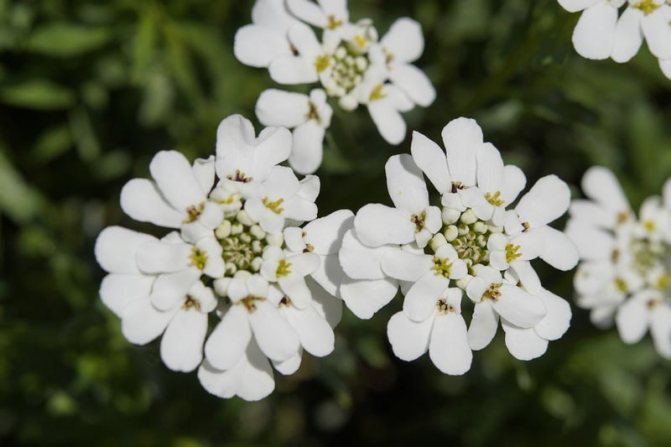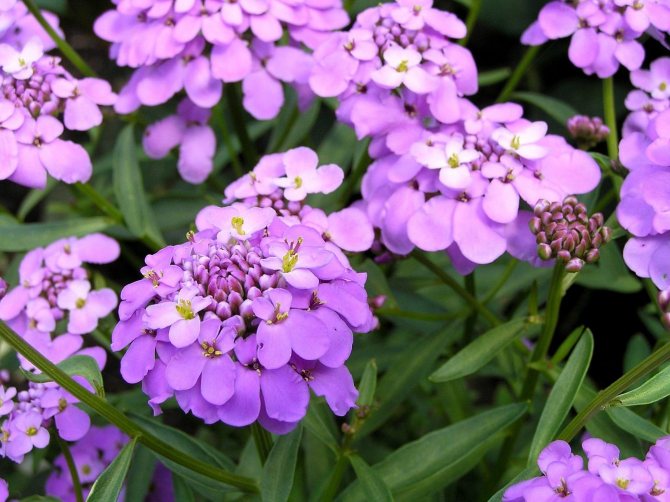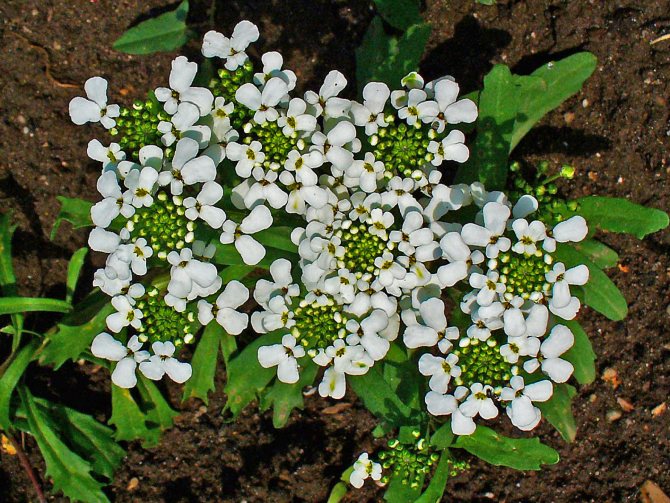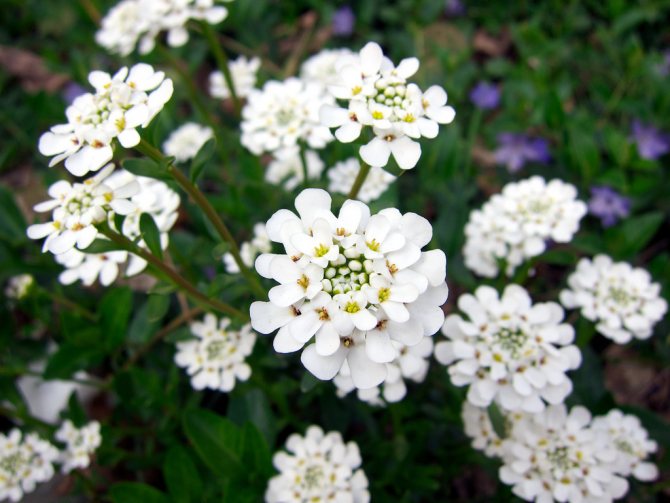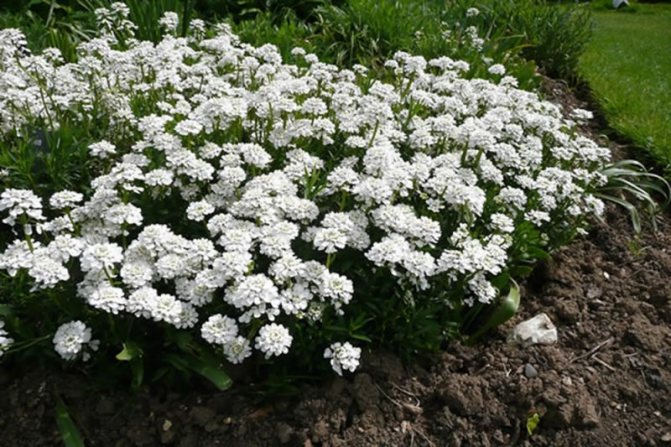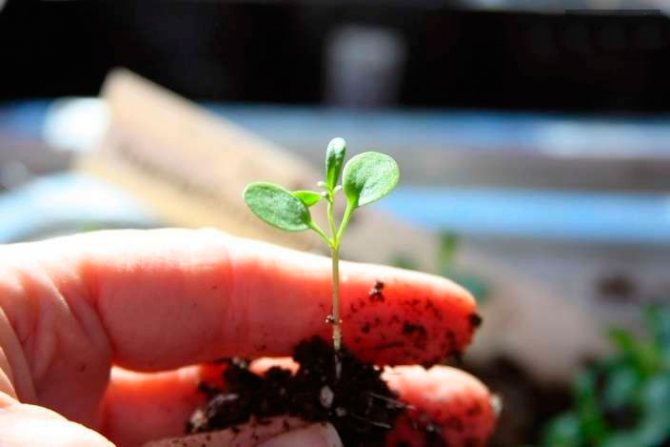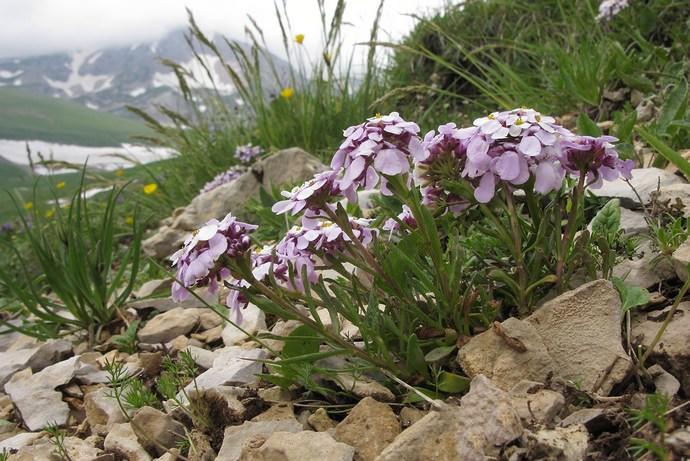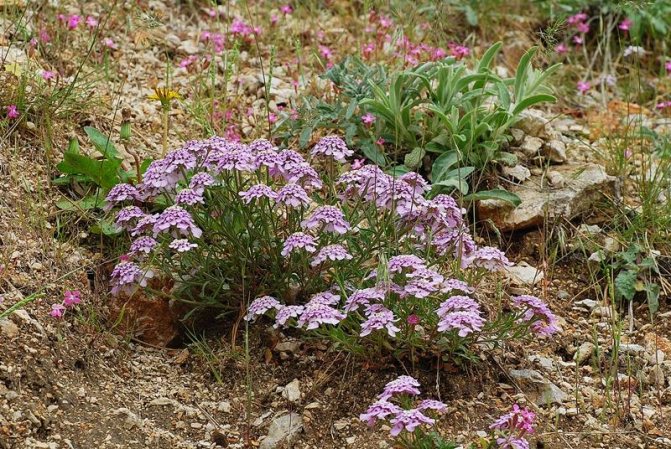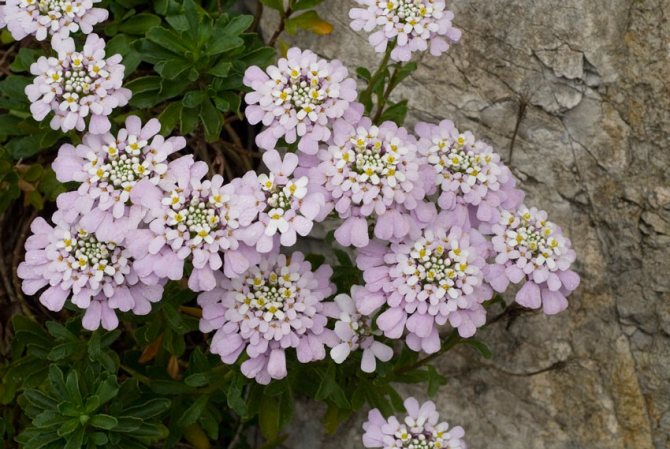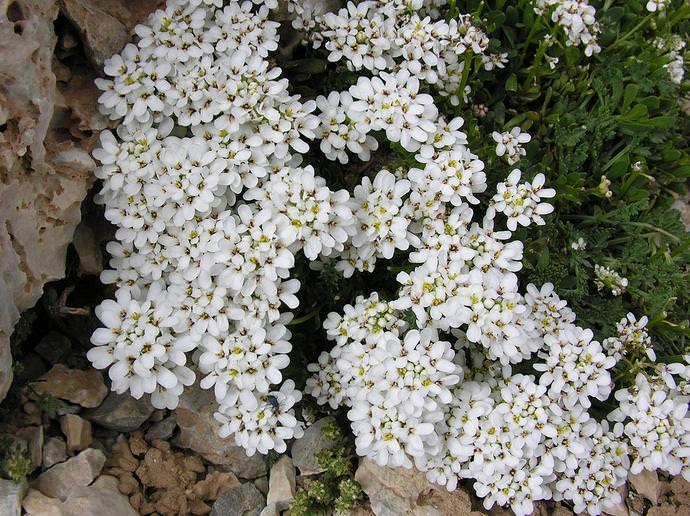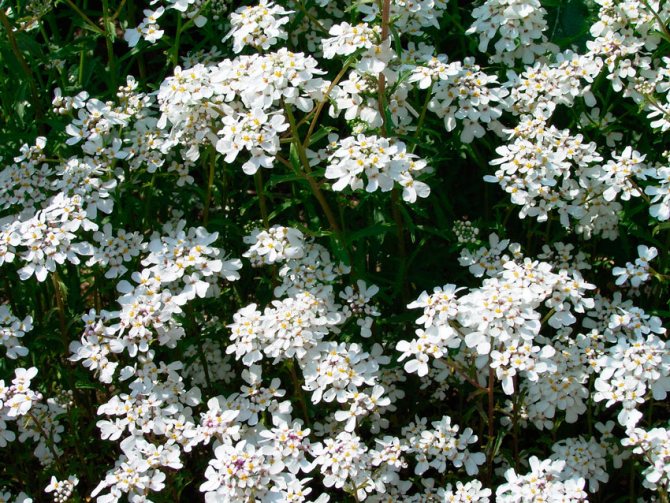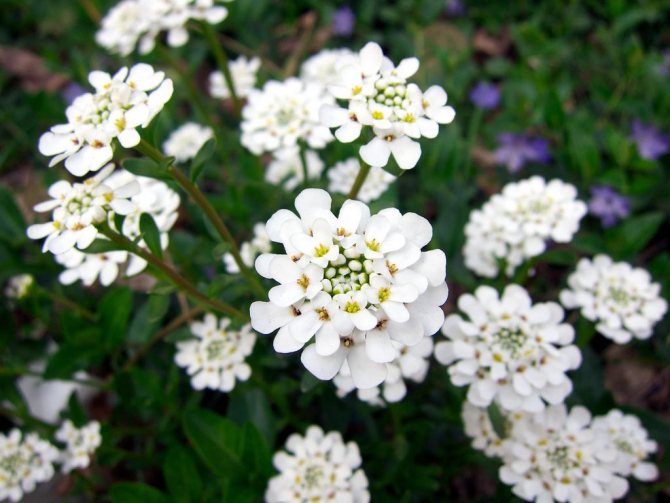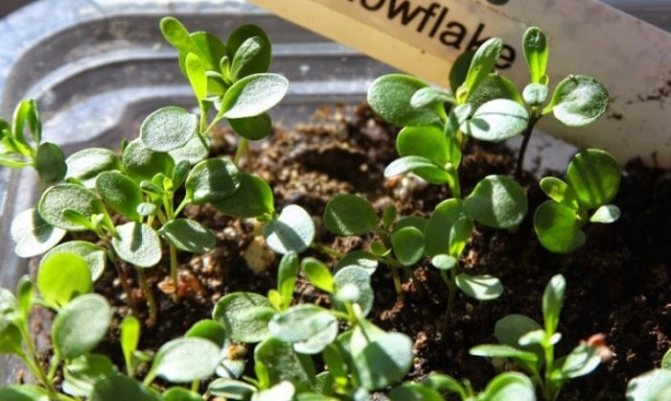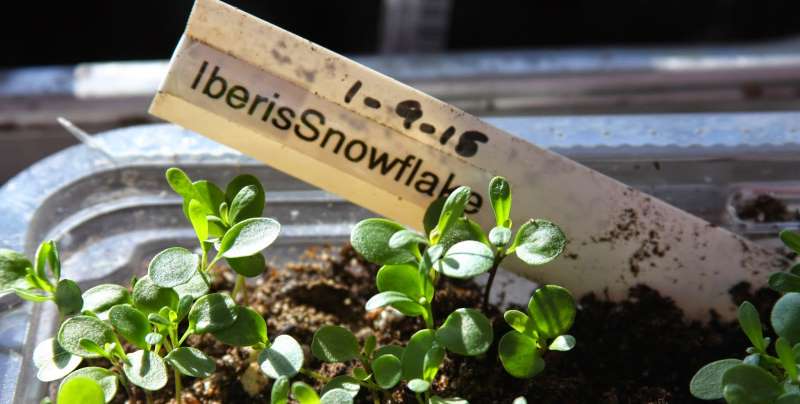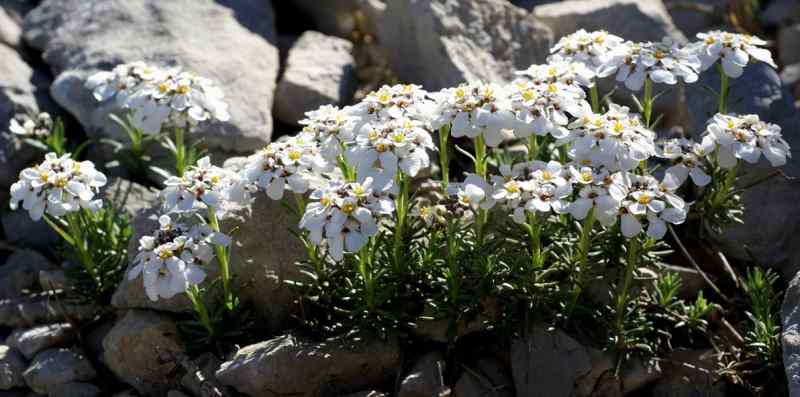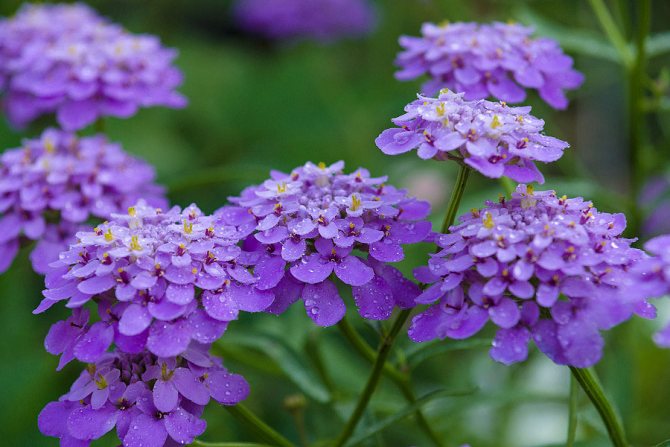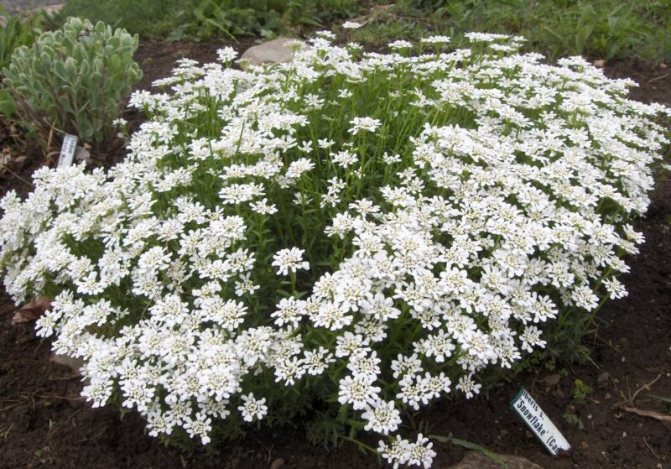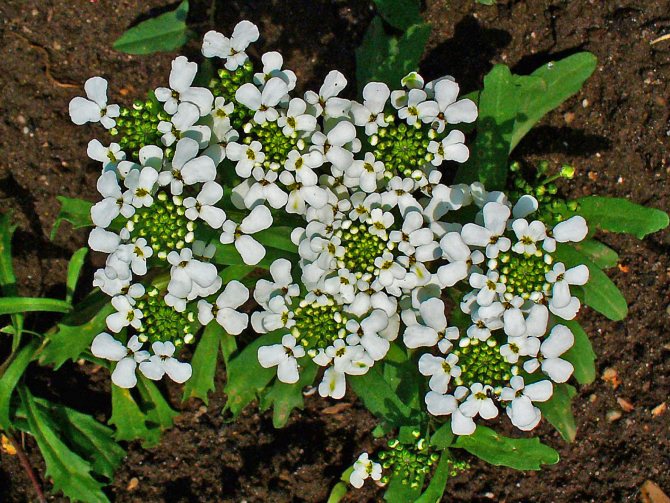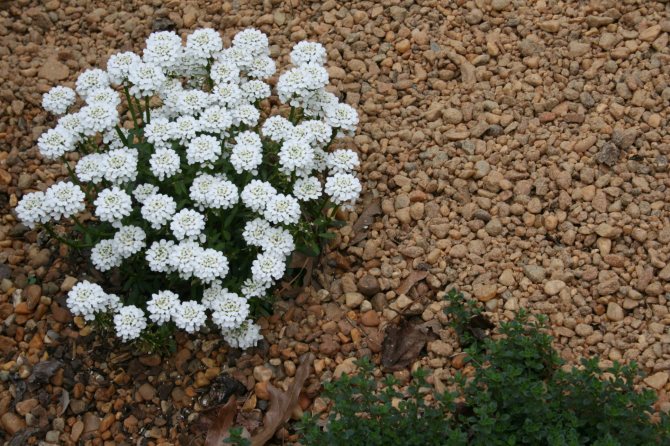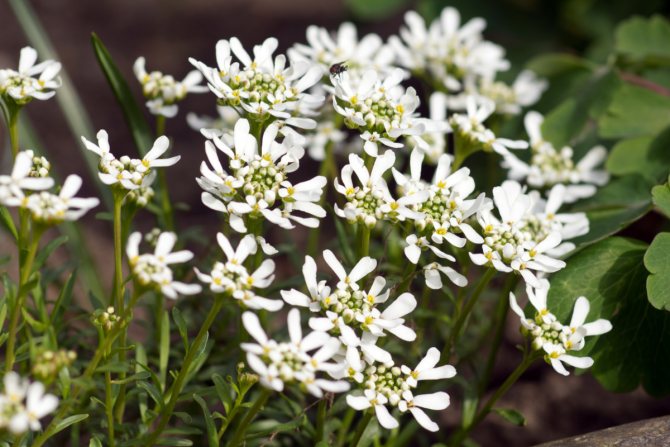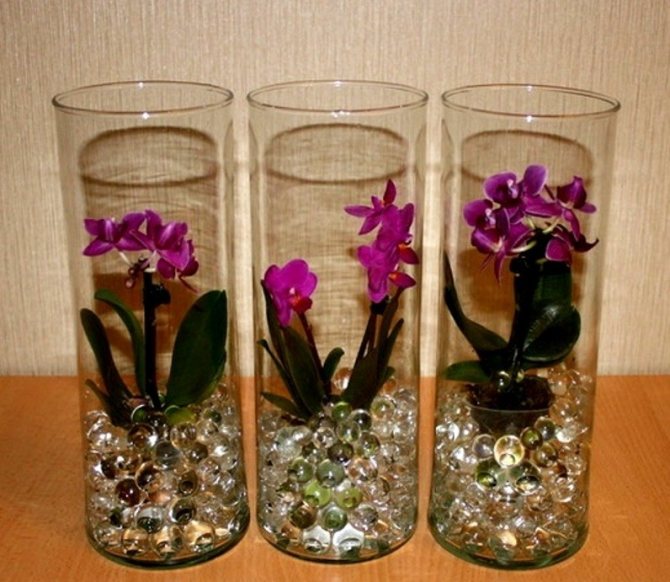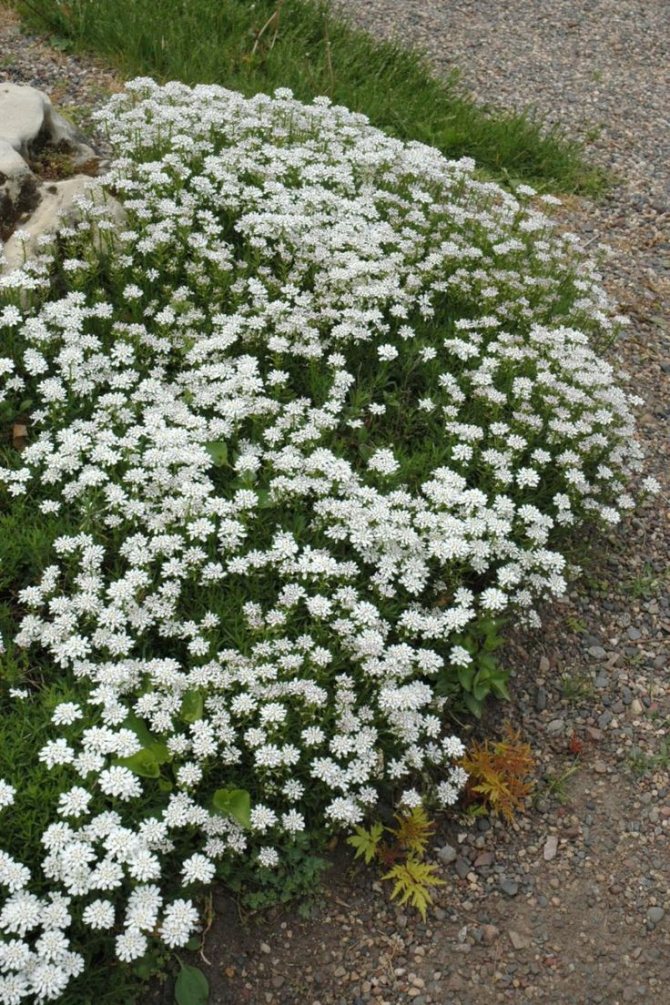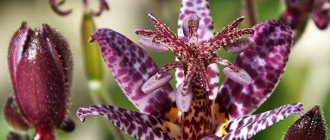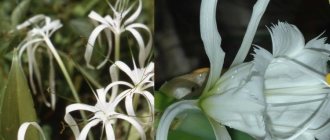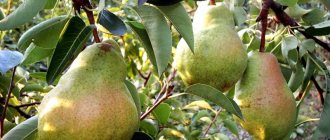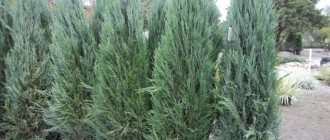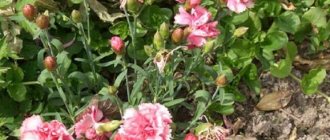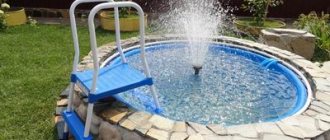Description of Iberis: varieties and varieties
The plant includes many subspecies, the height of which reaches 10-45 cm. The culture is distinguished by a squat tree-like base and has green shoots that are directed upward. Some Iberis flowers have branches spread horizontally.
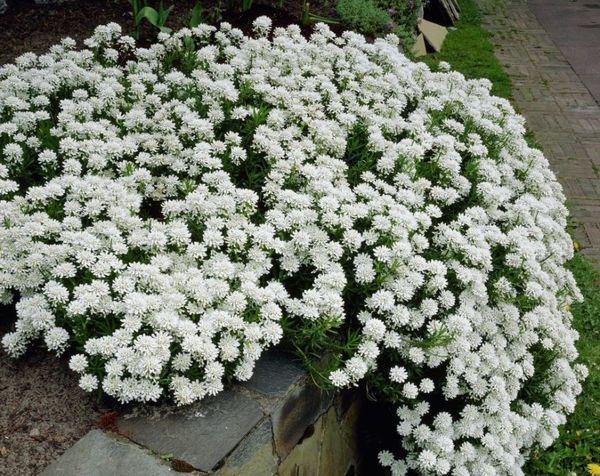
Iberis has excellent decorative properties
The plant has narrow, oblong leaves of a rich emerald color. Flowering begins in May and lasts two months. The bushes are decorated with many buds. Iberis flowers are small, they are placed on the plant in bunches. They can be of different colors - white, purple, red, lilac or pink.
After pollination, small pods filled with seeds appear on the bushes. Within 2-4 years, they can be used for planting.
According to the lifespan, Iberises are annual and perennial. The first group includes umbellate and bitter Iberis.
Bitter Iberis has pubescent stems that reach 30 cm in height. The leaves of the plant are small, pointed. The bushes are decorated with small white flowers.
Umbellate Iberis has a branched structure. Its stems are not covered with fluff. The plant reaches a height of 40 cm. It is decorated with white inflorescences, which are present on the bushes for up to 3 weeks. Iberis umbellate varieties Pomegranate Ice has spectacular white-red buds.
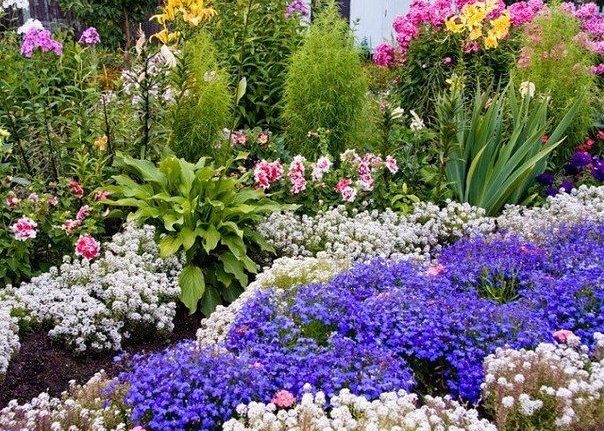

The plant has many varieties
Perennials include the following types of plants:
- Iberis is evergreen. This is one of the most common varieties that can be used to decorate any garden. The culture is characterized by many white inflorescences. It is very easy to care for white Iberis. It needs to be watered in dry weather and wilted flowers removed. Famous varieties of evergreen Iberis: Whiteout, Snowflake, Findall.
- Gibraltar. This plant is unpretentious, so many growers prefer to grow it. The culture has a neat appearance and pale purple inflorescences. The bushes grow no more than 10-15 cm. A popular variety of such an Iberis is Candytaft.
- Crimean. The culture is a low perennial plant. It grows to a maximum of 9-12 cm. Before blooming, the buds are light purple, then they turn white.
- Rocky. This plant spreads along the ground. In height, its shoots do not exceed 15 cm. The rocky Iberis is characterized by abundant flowering, during which foliage is practically invisible.
- Chameleon. The petals of this species shimmer beautifully from white-pink to violet. The culture is characterized by a pleasant sweet aroma.
Appreciate the beauty of an overseas flower
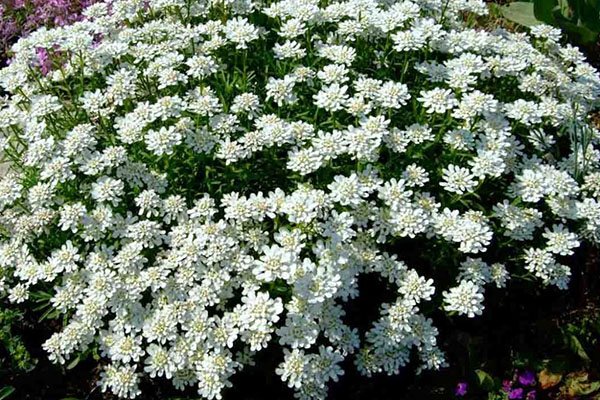

Almost all types of stennik are stunted plants that gracefully spread along the ground. Thanks to this, with its help, original garden landscapes are created. Iberis evergreen feels great among the stones on the alpine hills. When flowers bloom in early spring against the background of dark green leaves, there is no limit to admiration.
The plant is prized for its external beauty and unsurpassed aroma. This fact should be taken into account by those who are allergic to odors.
A stunted shrub of Iberis grows up to half a meter. It has many dense branches, which are tree-like at the bottom of the bush, and tender and flexible at the top.Small, dark green leaves are located close to each other, creating a solid head. Shoots usually grow vertically upward, spreading in nature. A photo of evergreen Iberis will help you to consider all its charms.
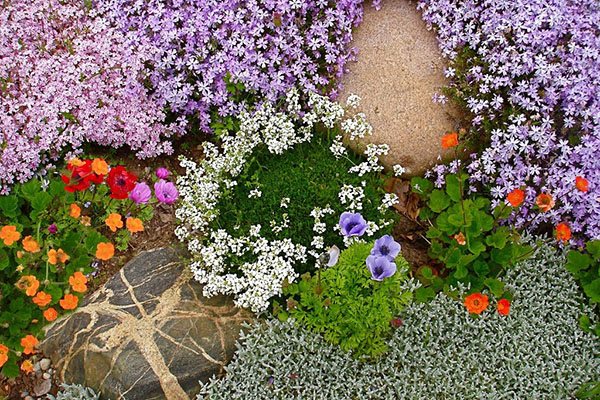

The types of this plant known today are:
- Bitter. It is a low-growing version up to 30 cm. The flowers are white with a delicate purple tint.
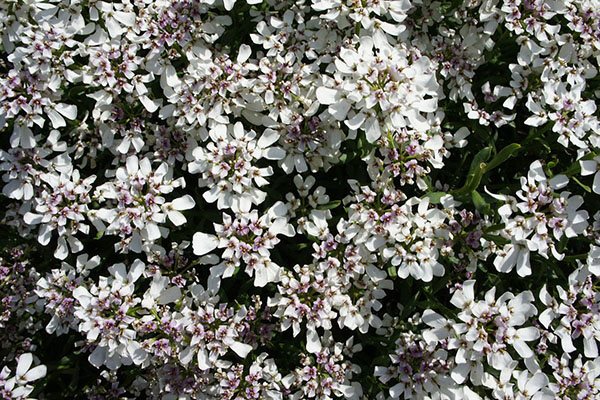

- Umbrella. Annual plant, up to 40 cm high. Dense inflorescences of pink or lilac hue. They have a strong aroma.
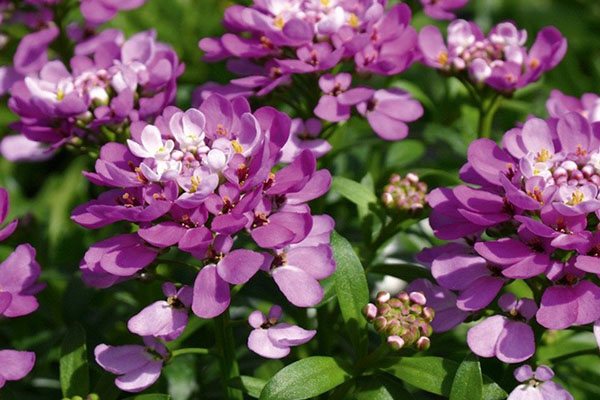

- Gibraltar. Perennial shrub. Has corymbose inflorescences of lilac color.
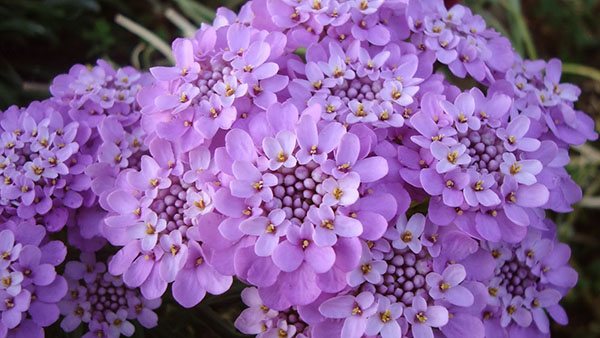

In general, we can say that Iberis is an original fluffy plant with an unusual flow of inflorescences.
Planting site, soil
Perennial sweet peas - grown from seeds
The culture grows well, blooms profusely and looks attractive in well-lit areas. Although the planting of Iberis can be carried out in a shaded place. Culture is often used in the design of alpine slides and rockeries, choosing not the sunniest areas.
Important! In order for the flower to grow fully and bloom profusely, it needs loamy soil. Iberis should not be planted in too dense or dry soil.
Iberis: growing from seed, when to plant
The culture is grown by seed or vegetative method. Most often, it is planted with seeds. Many varieties of the plant are grown outdoors.
Seeds are recommended to be planted in April. If you need to extend flowering until the end of September, they are planted twice. At the same time, it is necessary to sow planting material at intervals of 2-3 weeks.
The first shoots will appear in 1-2 weeks. At this point, the bushes must be thinned out. Iberis rises amicably enough, so the distance between flowers needs to be 12-15 cm.
Also, the culture is planted in open ground before winter. Thanks to this, the sprouts will appear in the spring.
Planting seedlings
If you plan to grow Iberis from seeds, when to plant them for seedlings? It is best to do this in mid-March. Seed material is placed in the ground 1 mm. From above it must be sprinkled with river sand and covered with glass. Thanks to this, it will be possible to maintain the required soil and air moisture.
Planting should be in a warm and bright place. Water the plants very carefully. It is best to use a spray bottle for this purpose. Iberis has a rather fragile root system, so it is not recommended to dive the bushes.
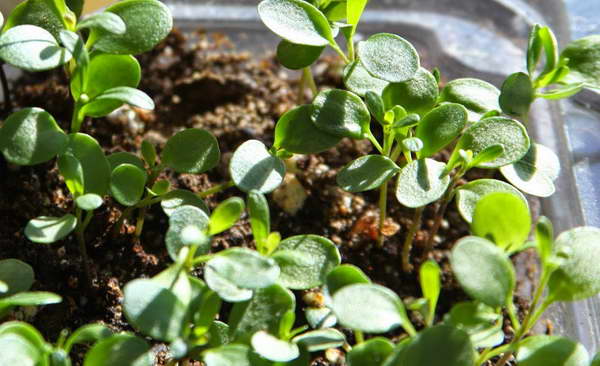

The culture can be grown in seedlings.
Outdoor Iberis Care
Even such an unpretentious flower has its own nuances in care.
So, in order for the plant to delight you with magnificent flowering, it is important to remember the following rules:
- Rule 1. Be sure to loosen the soil as often as possible. Iberises adore loose soil, and this procedure also facilitates the access of oxygen to the roots. If the soil is too dense, try adding additives such as sphagnum, charcoal, sand, vermiculite, or perlite. Cultivars that prefer calcium-rich soil can be pampered with eggshells. Just chop it up and scatter it under the bushes.
- Rule 2. Remove weeds in a timely manner. Uninvited guests will "steal" nutrients and moisture from the flower. This can lead to shorter flowering times. Inflorescences can also become small and inconspicuous. To reduce weeds, you can cover the soil with a special non-woven fabric. Weed the ground first and then cover it up. In addition to the fact that the weeds will sprout much more slowly, the soil will gradually be fertilized with humus.
- Rule 3. Remove faded flowers and dead branches. Perennials must be cut off closer to cold weather - by about one third.
- Rule 4. After five years, the plant loses its decorative effect. Therefore, it would be best to rejuvenate it with cuttings or grow it from seeds.
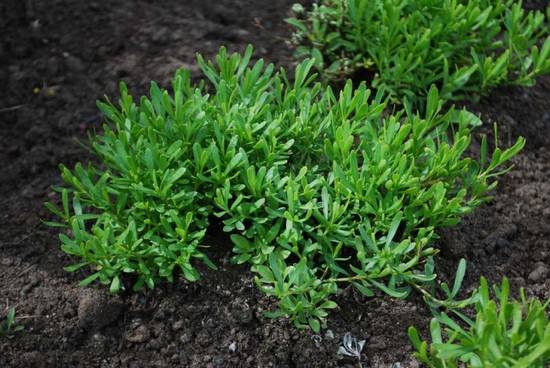

Iberises love loose soil
As for the question of fertilizers, some people think that this is superfluous. Alas, sometimes the flower may lack minerals from the soil. It is best to choose fertilizers without a lot of nitrogen, as it interferes with flowering. Nitrogen is focused on the growth of green mass of Iberis. Here are some home dressing recipes:
- Dry the banana peel completely. Grind and add to the ground under the flower. You can simply make an infusion of banana skins. They contain a huge amount of trace elements. Chop the banana skin and pour boiling water over it. Let stand in a warm place until fermentation begins. Water the flower. The method is also suitable for indoor plants.
- We dilute 200 grams of ash in a bucket of water. Water or spray.
- Ordinary potassium permanganate is also a wonderful fertilizer, although it has been undeservedly forgotten. It is enough to spill the soil with a weak solution a couple of times over the summer in order to replenish the reserves of potassium and manganese in it.
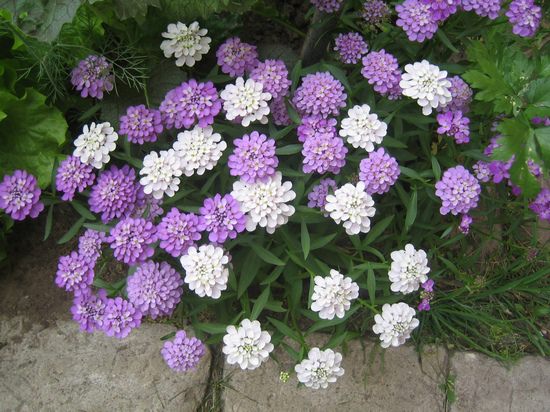

Iberis does not tolerate waterlogging of the soil
Watering and loosening the soil
Perennial Gelenium - planting and care in the garden
Planting and caring for perennial Iberis in the open field have certain characteristics. It is necessary to water the culture only in very hot and dry weather. The soil must be completely saturated with water, but there should be no stagnation of liquid near the roots. Rare watering does not harm the culture.
After each moistening of the soil or precipitation, it is necessary to loosen the earth. This helps to saturate the roots with oxygen and nutrients.
Reproduction methods
Iberis can be propagated in different ways:
- survival of seeds;
- dividing the bush;
- by cuttings.
Seeds
Perennial small petals or Erigeron - planting and care
To obtain seedlings, seeds are planted in containers with peat in March. At a temperature of 18 ° C, sprouts appear after 10 days. They need to be slightly moistened. In open soil, the culture is moved in mid-May. You can plant seeds directly into the ground. This is done in April. Bushes grown by the seed method will bloom only in the second year.
By cuttings
For this procedure, you need to wait until the end of the flowering culture. From the shoots, it is necessary to cut small cuttings 5-8 cm in size. They should be soaked in a growth stimulator, and then transferred to moist soil.
Important! It is recommended to cover the landing site with a glass container, which is removed after the end of frost. In winter, the plants are additionally insulated with sawdust and soil.
By dividing the bush
An adult plant over 5 years old should be dug up in the spring before the start of the growing season. After cutting off the upper part, the bush must be divided into equal fragments and planted in prepared places. The soil around the shoots must be compacted and watered.
To decorate the garden plot, you can use ready-made seedlings, which are sold in flower shops. To choose high-quality planting material, you need to pay attention to its appearance. It is important that there are no symptoms of diseases or damaged areas on the bushes.
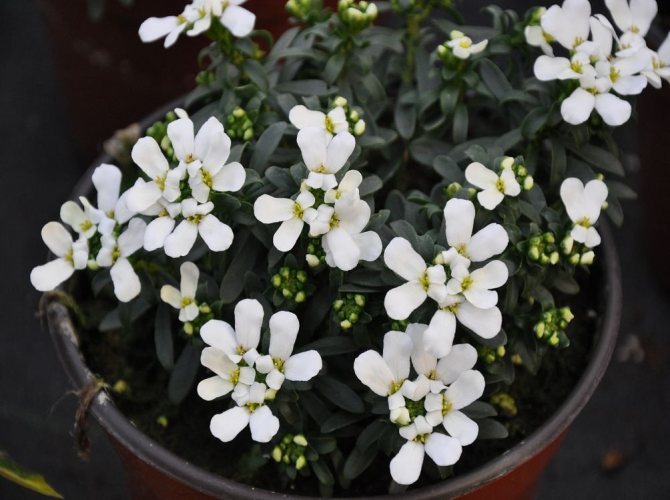

Iberis can be propagated in many ways.
Possible problems
The root system is the most vulnerable part of the Iberis. It is the roots of the plant that are often affected by the plasmodiophorabrassicae fungus, or, as the people call this attack, the cruciferous keel. This parasitic fungus causes root deformation and, as a result, weakening or complete cessation of the growth of the Iberis. Another pest fungus - Rhizoctonius (pelliculariafilamentosa) can also bring a lot of trouble, cause wilting and death.
Prevention of these diseases consists in disinfecting the soil, and treatment - in the timely removal of diseased plants to prevent further spread of the infection.Among insects, the main enemies of Iberis are: mealybugs; cabbage aphid. Their attack on bushes is fraught with yellowing and leaf fall, weak flowering, general oppression of plants. In the first case, treatment with anticoccides is carried out, in the second - with a solution of wood ash with soap. Iberis is ideal for alpine slides, rockeries, curbs, prefab foregrounds. Unpretentious and cute, it will add variety to the colors of your garden, add its unique color, charm and unforgettable aroma to it.
Top dressing and transplanting
The amount of fertilizer depends on the type and characteristics of the soil on the site. If the soil has a poor composition, standard complex fertilizers should be applied 2 times a year. In spring and summer, Nitrofoska can be used.
Important! An excellent option would be the use of organic fertilizers. They can be buried in the ground or used as a mulch layer.
An excessive amount of dressing causes the rapid growth of the bush. In such a situation, you will have to constantly adjust its size. When growing a flower in fertile soil, it is permissible to apply fertilizers once every 2-3 years.
It is often not recommended to transplant Iberis. If the taproot is damaged, it will quickly die off. This will lead to the death of the culture. Shrubs can be transplanted after 5 years. Older crops bloom more poorly, so plants need rejuvenation.
Pests and diseases
Iberis is often attacked by scale insects and earthen fleas. They eat the stems and leaves of the flower. To cope with parasites, you need to use special drugs. The drug Aktara is highly effective. It is important to systematically irrigate the soil around the bush.
In addition, the plant can suffer from aphid attacks. Its appearance can be suspected by whitish spots on the leaves and drying of flower shoots.
Important! To get rid of aphids, you should use a liquid potassium soap solution. You can also use tobacco broth.
The culture has a fairly weak root system. She often encounters fungal infections and rots. Alarming signs in this case include growths on the roots, a slowdown in the development of culture, and yellowing of the foliage.
To prevent infection with a fungus, it is necessary to treat the area with fungicidal preparations. It is recommended to do this before planting the crop in the soil. The affected plant must be destroyed, and the soil must be treated with the drug again.
Outcomes
The light charm of fragrant iberis blossoms will be a good addition to any landscape. Plants feel great in our climatic zone, they are easy to care for. If you plant a pepper pot along the edges of the curb, they will shine with new colors, they will look very extraordinary. The delicate palette of the stennik goes well with any culture, therefore, in the rock gardens and rocky hills, a representative of the cabbage genus will definitely take its place. An especially successful ensemble will turn out in combination with large-flowered bells, undersized marigolds, phlox. And with neighbors such as cypress and dwarf pine, Iberis will always live peacefully and amicably.
How to prepare for wintering
Iberis is a fairly frost-resistant plant, however, in a snowless and harsh winter, the culture can freeze. A perennial plant can hardly tolerate temperature fluctuations and a change from frost to thaw.
In order for the culture to endure the winter normally, even in the middle lane it needs to be covered. This procedure is carried out in the last decade of autumn. Fallen leaves and spruce branches will be an excellent protection against frost. Ordinary dry branches are also suitable. They need to make layers of hay and straw.
Application
Iberis is the first herald of warmth.In order for the bush to give early flowers, it is planted before winter in a place prepared in advance, then the first buds will be in May.
The golden flower is grown on balconies, in pots, in open flower beds, in flower beds, on flower walls. With its help, interesting alpine slides are performed. They form a decor in the style of "Natural chaos", where neat white balls are placed in the crevices. In addition, they are used for cutting - they stand in the water for a long time.
Tuberous begonias, phlox, saxifrage, sedum are grown next to Iberis. White edges favorably set off bright floral arrangements. On alpine slides, they are planted in such places and on surfaces in order to visually smooth out protruding sharp edges. To keep the flower compact and rounded, it is formed. Pruning is done immediately after flowering.
In addition, in order for Iberis to bloom longer, a little trick is used: the planting time is torn by 2 weeks. Thus, each planted shoots later bloom 2 weeks later at a different time, and the effect of constant flowering is obtained. To obtain interesting colors, Iberises of various types are planted nearby.
Flowering period and care after
Iberis have a special bud development schedule. The culture blooms in May and August. At the same time, lush flowers decorate the bushes not too long - on average 2 months. After flowering is complete, oval or bivalve pods appear on the plants. Inside, they are filled with seeds.
Important! After the end of flowering, the stems need to be cut by a third. Thanks to this, it will be possible to make the bushes more neat.
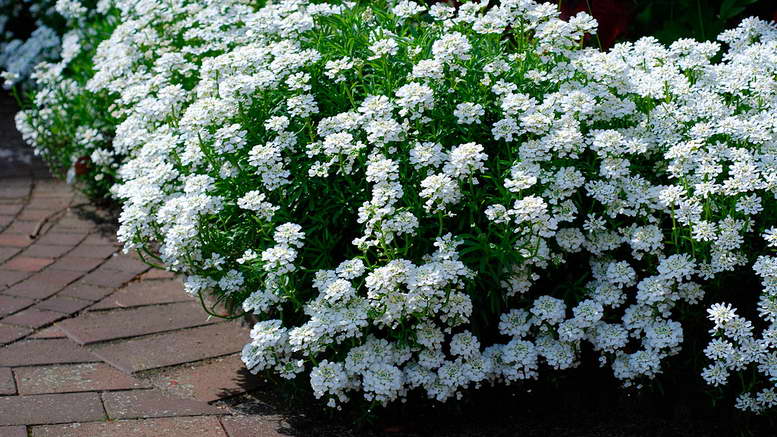

With proper care, Iberis blooms profusely
Culture characteristics
The plant has a rod-type root system, so it does not tolerate transplants. The length of the stems varies depending on the species: creeping or erect. Iberis leaves are small, simple, dark green in color. The flowers of the plant are small, rarely exceeding 1 cm in diameter. Several Iberis flowers form umbrella-shaped inflorescences, which are so densely located that sometimes no leaves are visible behind them.
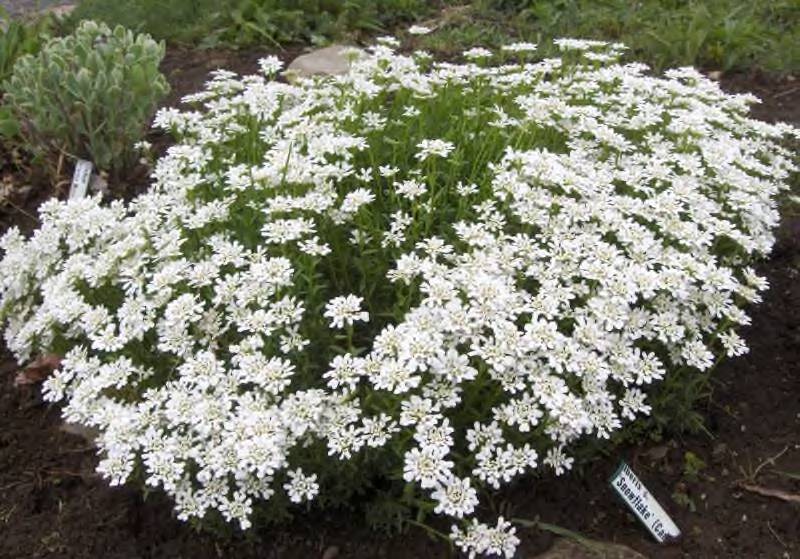

The plant blooms in May or August, and continues to bloom for up to two months, with annual varieties blooming longer. Iberis seeds can be stored for up to 4 years without losing their properties. It is worth noting the pleasant smell of flowers, which can fill the entire area with aroma. The fruits of the plant are a round or oval bivalve pod with a notch at the top.


